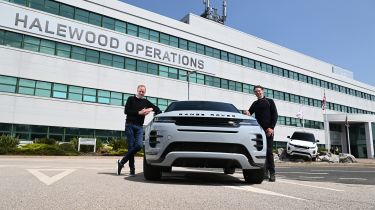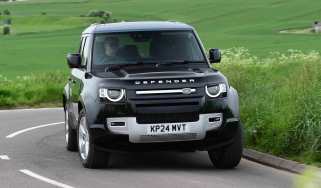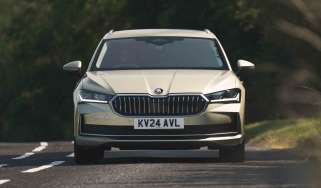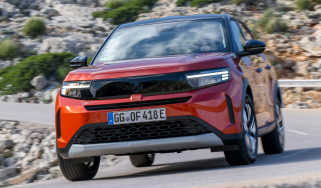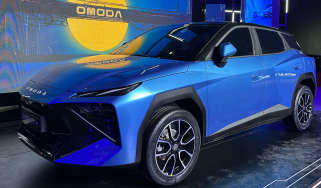Range Rover's secret mid-size EV: Inside its £500m factory
We take an exclusive look inside JLR’s revamped Liverpool site as the brand gears up for EV production
The Halewood factory has churned out nine million cars: some fabulous (the Ford Escort Mk1), some derided (the Jaguar X-Type), some both (the Ford Capri). But none of them are powered solely by electricity.
All that will change in 2026, when an all-new mid-size Range Rover starts rolling out of a brand-new body facility. Jaguar Land Rover (JLR) is overhauling its Liverpool production hub with a £500million staggered investment, and Auto Express has ventured inside for a sneak preview.
Planning to introduce a new Electric Modular Architecture (EMA) began four years ago, triggering Halewood’s transformation into a hi-tech digital factory building a unique electric Range Rover. The new 4x4 will be similar in size to the existing Velar, but stands apart due to its long wheelbase, low roof and zero-emissions running.
Assembling today’s petrol/hybrid Velar will continue at the Solihull plant, embodying JLR’s “parallel production” philosophy as it overhauls its vast industrial footprint. So the EMA’s e-motors will be made alongside Ingenium petrol engines in Wolverhampton, and Solihull will also make flagship Range Rover EVs and hybrids, while Halewood merges its smaller EV with venerable 4x4s.
Daniel Ford, director of global manufacturing engineering, is at the heart of Halewood’s rebirth. His team is spending 30,000 hours a week on the project, with the paint shop already refitted, robots and heavy plant shipped up from the former Jaguar factory in Castle Bromwich for reuse, and a new 32,000m2 body-assembly building finished.
Factory shorthand to give a sense of scale is to say how many football pitches fit inside (4.48 should you ask), but JLR went one better: it put a pop-up pitch inside the empty hall, inviting Premier League club Everton to host some training. It’s outreach from a plant that’s the beating heart of the community, with half of the workers coming from the deprived Knowsley neighbourhood.
The body-assembly extension towers over two storeys, requiring double-sized, 20-metre foundations to be sunk into ground softened by the River Mersey. Why? “It's like building a bungalow in Manhattan: an expensive way to use your space. So go up,” says Ford. And up we go, climbing a steep staircase to survey the upper assembly hall where engineers are installing an army of robots, many lined up like the hangar scene in the movie iRobot. Ultimately there will be 250 in the hall, overseen by 30 people.
Welding cells unfurl before us, robot arms frozen in suspended animation, awaiting the call to start turning metal into vehicle engine bays, main floors and rear floors, plus sub-assemblies that will be ‘framed’ into a whole body-in-white downstairs. These parts are made in a separate area because the EMA architecture – with its battery housing – is distinct from the Premium Transverse Architecture that underpins Land Rover’s Discovery Sport and Range Rover Evoque.
Boosting automation should help JLR unlock better quality. Measuring devices will scrutinise each frame to ensure a precise aperture into which robots will mount and bolt the doors, for example. “The automatic door-to-body system will require less finessing than a manual process,” explains Ford.
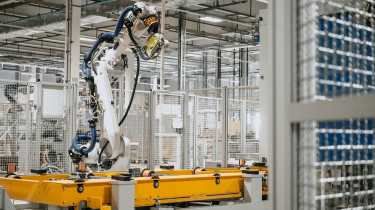
Lots of car companies talk nebulously about digital factories of the future, but our Halewood trip really brings the benefits to life. Early on, architectural consultants scanned every metre of the physical factory, even down to the pipework and wiring, to create its 3D digital twin. The intricate puzzle of deciding where equipment goes becomes so much easier when you can make any planning mistakes on a virtual assembly line. And the installation teams can check their work against the 3D visualisation.
The machines will be connected, with tooling programmed to tighten bolts to precise torque settings, and the shop floor linked to the logistics hub to ensure there are no costly interruptions to parts supply. Machinery will even be able to sign itself off sick. “We can see facility health so much better,” Ford tells us, “so we may not need to [service equipment] as many times as before and we can put our maintenance resource elsewhere”.
We also visit the new £3million training centre, where 1,900 of Halewood’s 3000 direct employees have already been reskilled for the battery-electric future. Training guru Andy Coleman watches as I complete a warm-up dexterity test and practise tightening up bolts with a torque wrench. It’s even more fun to use an Evoque body-in-white as a climbing frame, to understand how to safely enter and where to crouch to fit parts. JLR will layer digital training on top, too, with associates wearing virtual-reality goggles to create training videos on how to trim a new Range Rover that isn’t physically there.
It’s a step on from paper-based training manuals. Nonetheless the printed ‘shipper’ – the customer’s build spec taped to the car – still soldiers on. “On a screen it can be out of eyeline,” explains manufacturing engineer Ford.
JLR upgraded the first-floor paint shop in 2023, to boost capacity for the two-tone finishes popular among Range Rover buyers. The quality inspection centre, with an enlarged but more water-efficient monsoon testing facility, is gearing up to scrutinise EVs.
And now Ford’s team is focused on the biggest overhaul of the trim shop since the Jaguar X400 – the X-Type – was introduced around the millennium. Everything starts with the ‘cube’: essentially the cubic volume of the new models that must be carried into paint, then body storage before finally going down the trim line. “Since the X-Type, every model iteration is slightly wider, slightly longer, slightly taller, definitely heavier. So you start by making sure that your facility is able to accept the car,” explains Ford. Today Halewood’s biggest car is the 4.6m-long Discovery Sport: the EV will likely be a couple of hundred millimetres longer.
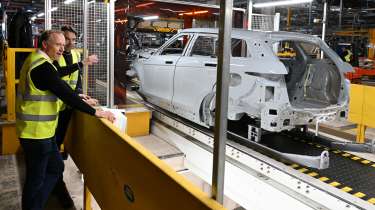
And that means new vehicle carriers. Laid out like a mortuary for yellow JCB parts are shrink-wrapped extension kits, to be bolted to the carriers to transport the bulkier EMA cars. Some 60 of 303 have been upgraded so far.
Our minders unlock a gate leading behind a mesh fence, and gaze into the painted bodies’ storage tower. Constructed at weekends, the new 12-storey hub replaced one built 30 years ago, which was too small for the cube and increasingly hard to service.
It can hold 600 bodies, which is the sweet spot between body assembly output and the trim line’s supply chain. Within 80 seconds, a shell can be picked up and gracefully lowered into the trim hall despatch area. “We need it connected to the broader factory landscape and made more efficient. What worked in 1995 doesn’t work in 2025,” says Ford, who previously spent nine years bedding Jaguars into Castle Bromwich.
Bodies are dropped onto a conveyor where a protective ‘puck’ is fitted, preventing any damage to hybrid batteries when a car is being jacked-up. The EMA pack – not expected to be a load-bearing part of the car, unlike in BYDs – will need similar safeguarding.
Batteries will arrive fully dressed from Tata’s plant in Bridgwater, Somerset. After quality checks they’ll be loaded onto Autonomous Mobile Robots, which will glide onto the line to be united with an EMA chassis at the battery-marriage station.
“EV batteries are so big, some in the industry need 22 fixings. And they’re so heavy that adding their weight can change the [alignment] of the body, so there’ll be a huge focus to get [slim] panel gaps,” says Ford.This feels like the pinnacle of Halewood’s parallel production: combustion engines, hybrid drivetrains and EV batteries – for two different vehicle architectures – wending their way along the same trim line. That epitomises JLR’s Reimagine strategy, the company’s strategic overhaul of its cars, technologies and factories, says Halewood’s operations director Brian Stone.
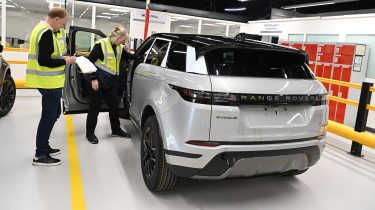
“Reimagine is about every nameplate having an electric offering by 2030, linked to [JLR’s target] of carbon neutrality in 2039. We’re taking a traditional OEM and completely pivoting into the electrified world,” Stone says.But Halewood’s boss – who started at the factory as a 16-year-old apprentice and racked up 27 years on site before stints at Solihull and running JLR’s Chinese manufacturing joint venture – thinks parallel production is the perfect hedge for an uncertain car market.
“We’re a global manufacturer servicing more than 140 countries around the world. If you look at the different rates that markets are transitioning to full BEV, this is where parallel production is so important. We want to process common things together, only separating out what is truly unique.”
Stone talks of his pride at getting the first electric-only Range Rover in his hometown plant. The initial £250million upgrades the facility for EMA, then a similar amount will convert it to EV-only when the time is right. Halewood is on a single shift producing an SUV every 90 seconds, and currently makes around 60,000 vehicles a year. The new electric Range Rover should put it back on an upward trajectory, aspiring to its 185,000 peak when the Evoque was running red hot.
It’ll be 2026 before car buyers get to decide if this new electric Range Rover is, like its Halewood forebears, fabled, derided or something in between. Regardless, Brian Stone will be focused on keeping the factory rolling, supporting 18,000 jobs and adding £1billion to the UK economy.
Tell us which new car you’re interested in and get the very best offers from our network of over 5,500 UK dealers to compare. Let’s go…
Find a car with the experts

